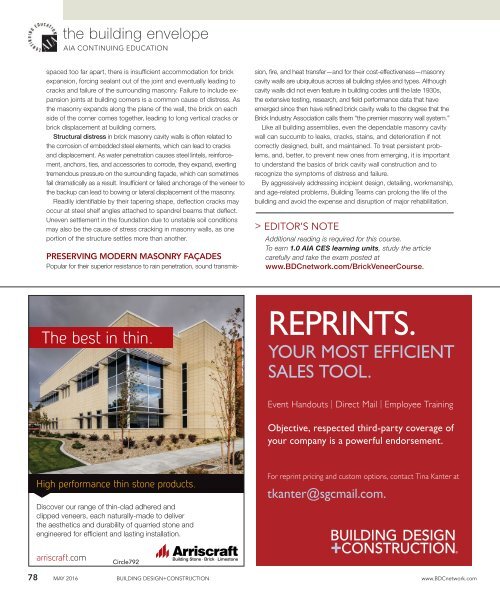Building Design Construction
Create successful ePaper yourself
Turn your PDF publications into a flip-book with our unique Google optimized e-Paper software.
the building envelope<br />
AIA CONTINUING EDUCATION<br />
spaced too far apart, there is insuffi cient accommodation for brick<br />
expansion, forcing sealant out of the joint and eventually leading to<br />
cracks and failure of the surrounding masonry. Failure to include expansion<br />
joints at building corners is a common cause of distress. As<br />
the masonry expands along the plane of the wall, the brick on each<br />
side of the corner comes together, leading to long vertical cracks or<br />
brick displacement at building corners.<br />
Structural distress in brick masonry cavity walls is often related to<br />
the corrosion of embedded steel elements, which can lead to cracks<br />
and displacement. As water penetration causes steel lintels, reinforcement,<br />
anchors, ties, and accessories to corrode, they expand, exerting<br />
tremendous pressure on the surrounding façade, which can sometimes<br />
fail dramatically as a result. Insuffi cient or failed anchorage of the veneer to<br />
the backup can lead to bowing or lateral displacement of the masonry.<br />
Readily identifi able by their tapering shape, defl ection cracks may<br />
occur at steel shelf angles attached to spandrel beams that defl ect.<br />
Uneven settlement in the foundation due to unstable soil conditions<br />
may also be the cause of stress cracking in masonry walls, as one<br />
portion of the structure settles more than another.<br />
PRESERVING MODERN MASONRY FAÇADES<br />
Popular for their superior resistance to rain penetration, sound transmission,<br />
fi re, and heat transfer—and for their cost-effectiveness—masonry<br />
cavity walls are ubiquitous across all building styles and types. Although<br />
cavity walls did not even feature in building codes until the late 1930s,<br />
the extensive testing, research, and fi eld performance data that have<br />
emerged since then have refi ned brick cavity walls to the degree that the<br />
Brick Industry Association calls them “the premier masonry wall system.”<br />
Like all building assemblies, even the dependable masonry cavity<br />
wall can succumb to leaks, cracks, stains, and deterioration if not<br />
correctly designed, built, and maintained. To treat persistent problems,<br />
and, better, to prevent new ones from emerging, it is important<br />
to understand the basics of brick cavity wall construction and to<br />
recognize the symptoms of distress and failure.<br />
By aggressively addressing incipient design, detailing, workmanship,<br />
and age-related problems, <strong>Building</strong> Teams can prolong the life of the<br />
building and avoid the expense and disruption of major rehabilitation.<br />
> EDITOR’S NOTE<br />
Additional reading is required for this course.<br />
To earn 1.0 AIA CES learning units, study the article<br />
carefully and take the exam posted at<br />
www.BDCnetwork.com/BrickVeneerCourse.<br />
The best in thin.<br />
REPRINTS.<br />
YOUR MOST EFFICIENT<br />
SALES TOOL.<br />
Event Handouts | Direct Mail | Employee Training<br />
Objective, respected third-party coverage of<br />
your company is a powerful endorsement.<br />
High performance thin stone products.<br />
Discover our range of thin-clad adhered and<br />
clipped veneers, each naturally-made to deliver<br />
the aesthetics and durability of quarried stone and<br />
engineered for efficient and lasting installation.<br />
For reprint pricing and custom options, contact Tina Kanter at<br />
tkanter@sgcmail.com.<br />
arriscraft.com<br />
Circle792<br />
78 MAY 2016 BUILDING DESIGN+CONSTRUCTION www.BDCnetwork.com






